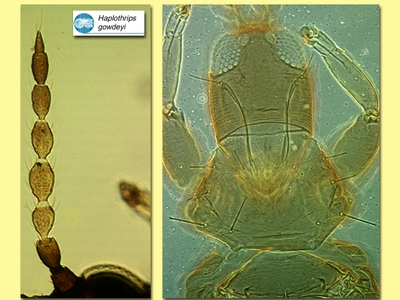Figures
Fig. 1 Antenna, head and pronotum
Fig. 2 Prosternal plates
Fig. 3 Fore and hind wing
Fig. 4 Tergite X (tube)
Fig. 5 Head, thorax and abdomen
Species
Haplothrips gowdeyi FranklinBiology
A flower-living species, but there are no studies to determine whether it is phytophagous or predatory, or both.
Distribution
Found worldwide throughout the tropics and subtropics.
Recognition
Large dark thrips, antennal segments III-V largely yellow; forewing pale with extreme base dark. Antennae 8-segmented; segment III with 2 sense cones, IV with 4 sense cones; segment III shorter than IV. Head with maxillary stylets about one-third of head width apart, with distinct maxillary bridge; postocular setae long with apex capitate. Pronotum with 5 pairs of dark major setae, all with capitate apex. Fore tarsus of female with small tarsal tooth. Forewing constricted medially; distal posterior margin with about 6 duplicated cilia; third sub-basal seta with apex blunt. Tergites II-VII each with 2 pairs of sigmoid wing-retaining setae; tergite IX major setae all with apex finely acute.
Related species
Amongst the 200 members of this genus, this species can be distinguished from most species in the tropics by the presence of two sense cones on the third antennal segment and the yellow colour of the median antennal segments.






